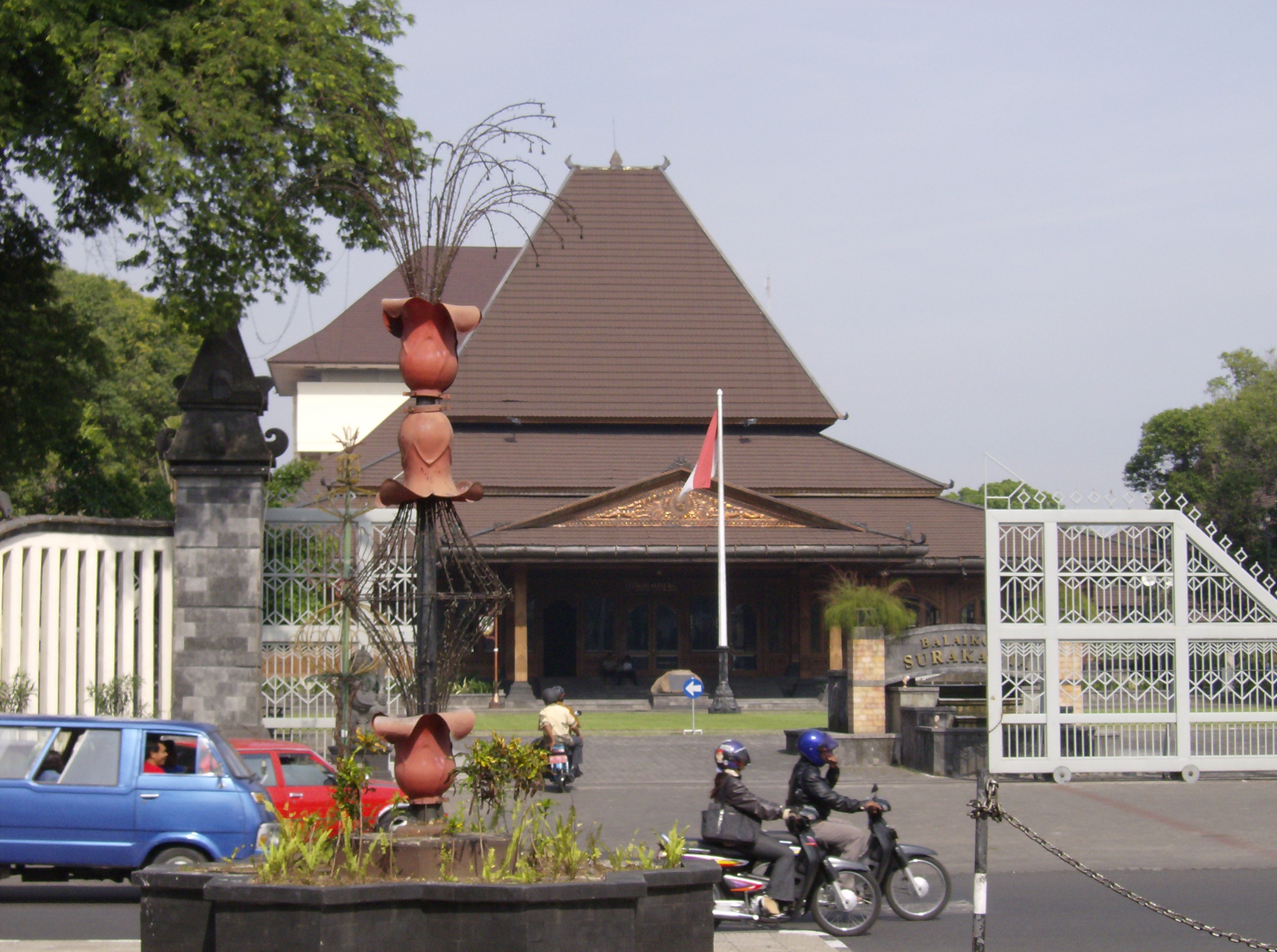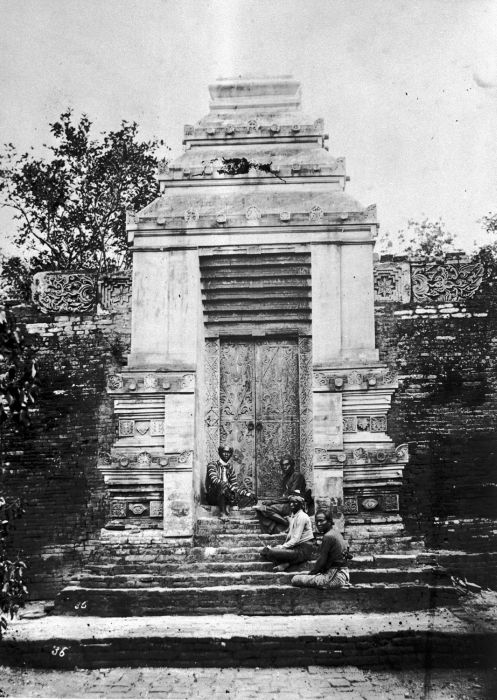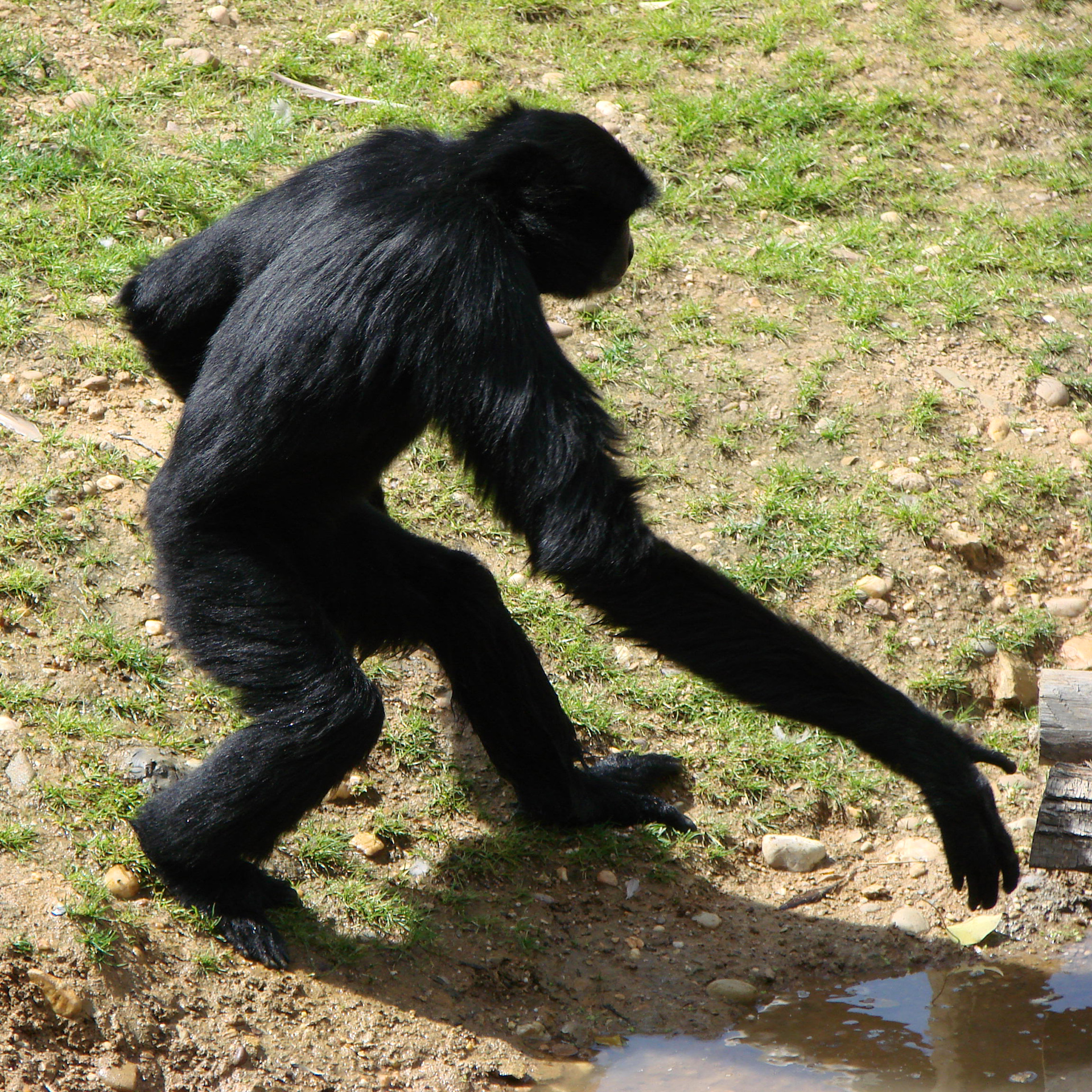|
Solo, Central Java
Surakarta ( jv, ꦯꦸꦫꦏꦂꦠ), known colloquially as Solo ( jv, ꦱꦭ; ), is a city in Central Java, Indonesia. The 44 km2 (16.2 sq mi) city adjoins Karanganyar Regency and Boyolali Regency to the north, Karanganyar Regency and Sukoharjo Regency to the east and west, and Sukoharjo Regency to the south. On the eastern side of Solo lies Solo River (Bengawan Solo). Its built-up area, consisting of Surakarta City and 59 districts spread over seven regencies ("Greater Solo Area", formerly Special Region of Surakarta), was home to 3,649,254 inhabitants as of 2010 census, around half million of which reside in the city proper. Surakarta is the birthplace of the current President of Indonesia, Joko Widodo. He served as Mayor of Surakarta from 2005 to 2012. History Hominid habitation in the region of Surakarta is evidenced from roughly one million years ago, the age of the "Java Man" skeleton found 80 kilometers upstream. Another famous early hominid from this area is called ... [...More Info...] [...Related Items...] OR: [Wikipedia] [Google] [Baidu] |
List Of Regencies And Cities Of Indonesia
Regencies (''kabupaten'') and cities (''kota'') are the second-level administrative subdivision in Indonesia, immediately below the provinces, and above the districts. Regencies are roughly equivalent to American counties, although most cities in the United States are below the counties. Following the implementation of decentralization beginning on 1 January 2001, regencies and city municipalities became the key administrative units responsible for providing most governmental services. Each of regencies and cities has their own local government and legislative body. The difference between a regency and a city lies in demography, size, and economy. Generally, a regency comprises a rural area larger than a city, but also often includes various towns. A city usually has non-agricultural economic activities. A regency is headed by a regent (''bupati''), while a city is headed by a mayor (''wali kota''). All regents, mayors, and members of legislatures are directly elected via ele ... [...More Info...] [...Related Items...] OR: [Wikipedia] [Google] [Baidu] |
Boyolali Regency
Boyolali ( jv, ꦧꦺꦴꦪꦭꦭꦶ, Boyalali, Don't forget) is a regency ( id, kabupaten) in the eastern part of Central Java province in Indonesia. It covers an area of 1,015.10 km2, and had a population of 930,531 at the 2010 census and 1,062,713 at the 2020 census. History The anniversary of the founding of Boyolali is celebrated on June 5, as the government of Kasunanan Surakarta created a new rule about the village government or the government outside the Kuthanegara (Capital City) on June 5, 1847. The rule was adopted pursuant to the ''treaty of Serat Perjanjian Dalem Natha'' entered into between Pakubuwono VII and the Dutch Government in the belief that the incumbent government was unable to fully function. The treaty is in the ''treaty of Serat Perjanjian Dalem Natha page 140 – 146'' or in ''Staatsblad 1847 No. 30. Chapter 30 – 36''. According to ''Staatsblad in 1847 No.30'', the Government of Kasunanan Surakarta formed six "Mountain Regencies" in its surrounding ... [...More Info...] [...Related Items...] OR: [Wikipedia] [Google] [Baidu] |
Mataram Sultanate
The Sultanate of Mataram () was the last major independent Javanese kingdom on the island of Java before it was colonised by the Dutch. It was the dominant political force radiating from the interior of Central Java from the late 16th century until the beginning of the 18th century. Mataram reached its peak of power during the reign of Sultan Agung Anyokrokusumo (), and began to decline after his death in 1645. By the mid-18th century, Mataram lost both power and territory to the Dutch East India Company (Dutch: ''Vereenigde Oost-Indische Compagnie''; ''VOC''). It had become a vassal state of the company by 1749. Etymology The name ''Mataram'' itself was never the official name of any polity, as the Javanese often refer to their realm simply as ''Bhumi Jawa'' or ''Tanah Jawi'' ("Land of Java"). ''Mataram'' refers to the historical areas of plains south of Mount Merapi around present-day Muntilan, Sleman, Yogyakarta, and Prambanan. More precisely, it refers to the Kota Gede ... [...More Info...] [...Related Items...] OR: [Wikipedia] [Google] [Baidu] |
Javanese Language
Javanese (, , ; , Aksara Jawa: , Pegon: , IPA: ) is a Malayo-Polynesian language spoken by the Javanese people from the central and eastern parts of the island of Java, Indonesia. There are also pockets of Javanese speakers on the northern coast of western Java. It is the native language of more than 98 million people. Javanese is the largest of the Austronesian languages in number of native speakers. It has several regional dialects and a number of clearly distinct status styles. Its closest relatives are the neighboring languages such as Sundanese, Madurese, and Balinese. Most speakers of Javanese also speak Indonesian for official and commercial purposes as well as a means to communicate with non-Javanese-speaking Indonesians. There are speakers of Javanese in Malaysia (concentrated in the West Coast part of the states of Selangor and Johor) and Singapore. Javanese is also spoken by traditional immigrant communities of Javanese descent in Suriname, Sri Lanka an ... [...More Info...] [...Related Items...] OR: [Wikipedia] [Google] [Baidu] |
Shorea Robusta
''Shorea robusta'', the sal tree, sāla, shala, sakhua, or sarai, is a species of tree in the family Dipterocarpaceae. The tree is native to India, Bangladesh, Nepal, Tibet and across the Himalayan regions . Evolution Fossil evidence from lignite mines in the Indian states of Rajasthan and Gujarat indicate that sal trees (or at least a closely related ''Shorea'' species) have been a dominant tree species of forests of the Indian subcontinent since at least the early Eocene (roughly 49 million years ago), at a time when the region otherwise supported a very different biota from the modern day. Evidence comes from the numerous amber nodules in these rocks, which originate from the dammar resin produced by the sal trees. Description ''Shorea robusta'' can grow up to tall with a trunk diameter of . The leaves are 10–25 cm long and 5–15 cm broad. In wetter areas, sal is evergreen; in drier areas, it is dry-season deciduous, shedding most of the leaves from February t ... [...More Info...] [...Related Items...] OR: [Wikipedia] [Google] [Baidu] |
1358
Year 1358 ( MCCCLVIII) was a common year starting on Monday (link will display the full calendar) of the Julian calendar. Events January–December * January 10 – Muhammad II as Said becomes ruler of the Marinid dynasty in modern-day Morocco after the assassination of Abu Inan Faris. * February 11 – Mohammed Shah I becomes Bahmani Sultan of Deccan (part of modern-day southern India) after the death of Sultan Ala-ud-Din Bahman Shah. * February 18 – Treaty of Zadar, between Louis I of Hungary/Croatia and the Republic of Venice: The Venetians lose influence over their former Dalmatian holdings. * March 16 – King Haakon VI of Norway designates the city of Skien as a city with trading privileges, making it the sixth town with city status in Norway. * May 28 – Hundred Years' War: The Jacquerie – A peasant rebellion begins in France, which consumes the Beauvais, and allies with Étienne Marcel's seizure of Paris. * June 27 – The Repub ... [...More Info...] [...Related Items...] OR: [Wikipedia] [Google] [Baidu] |
Majapahit
Majapahit ( jv, ꦩꦗꦥꦲꦶꦠ꧀; ), also known as Wilwatikta ( jv, ꦮꦶꦭ꧀ꦮꦠꦶꦏ꧀ꦠ; ), was a Javanese people, Javanese Hinduism, Hindu-Buddhism, Buddhist thalassocracy, thalassocratic empire in Southeast Asia that was based on the island of Java (in modern-day Indonesia). It existed from 1293 to circa 1527 and reached its peak of glory during the era of Hayam Wuruk, whose reign from 1350 to 1389 was marked by conquests that extended throughout Southeast Asia. His achievement is also credited to his prime minister, Gajah Mada. According to the () written in 1365, Majapahit was an empire of 98 tributaries, stretching from Sumatra to New Guinea; consisting of present-day Indonesia, Singapore, Malaysia, Brunei, southern Thailand, Timor Leste, southwestern Philippines (in particular the Sulu Archipelago) although the scope of Majapahit sphere of influence is still the subject of debate among historians. The nature of Majapahit relations and influences upon its ... [...More Info...] [...Related Items...] OR: [Wikipedia] [Google] [Baidu] |
Balitung
Sri Maharaja Rakai Watukura Dyah Balitung Sri Dharmodaya Mahasambu was the king of the Kingdom of Mataram. He reigned circa 899–911. His territories included Central Java, East Java, and Bali. In 907 he created the Mantyasih inscription (also known as Balitung's charter), containing the list of Mataram kings. He also mentioned in Kaladi inscription (c. 909 CE). Rise to power Historians such as Boechari and Poerbatjaraka argued that Dyah Balitung became the king as a result of his marriage to the daughter of his predecessor. It was speculated that his predecessor and his father-in-law is Rakai Watuhumalang, who according to the stele of Mantyasih ruled before Balitung. However, the reason Balitung inherited the kingdom may not be that of marrying the King's daughter, since he also had a son, Mpu Daksa, according to the stele of Telahap. An alternative explanation could be that after Rakai Kayuwangi's death, the kingdom was broken. This is confirmed with Maharaja Rakai Gurunwan ... [...More Info...] [...Related Items...] OR: [Wikipedia] [Google] [Baidu] |
Mataram Kingdom
The Mataram Kingdom (, jv, ꦩꦠꦫꦩ꧀, ) was a Javanese people, Javanese Hinduism, Hindu–Buddhism, Buddhist kingdom that flourished between the 8th and 11th centuries. It was based in Central Java, and later in East Java. Established by King Sri Sanjaya, Sanjaya, the kingdom was ruled by the Shailendra dynasty and Ishana dynasty. During most of its history the kingdom seems have relied heavily on agriculture, especially extensive rice farming, and later also benefited from maritime trade. According to foreign sources and archaeological findings, the kingdom seems to have been well populated and quite prosperous. The kingdom developed a complex society, had a well developed culture, and achieved a degree of sophistication and refined civilisation. In the period between the late 8th century and the mid-9th century, the kingdom saw the blossoming of classical Javanese art and architecture reflected in the rapid growth of Candi of Indonesia, temple construction. Temples d ... [...More Info...] [...Related Items...] OR: [Wikipedia] [Google] [Baidu] |
Solo Man
Solo Man (''Homo erectus soloensis'') is a subspecies of ''H. erectus'' that lived along the Solo River in Java, Indonesia, about 117,000 to 108,000 years ago in the Late Pleistocene. This population is the last known record of the species. It is known from 14 skullcaps, two tibiae, and a piece of the pelvis excavated near the village of Ngandong, and possibly three skulls from Sambungmacan and a skull from Ngawi depending on classification. The Ngandong site was first excavated from 1931 to 1933 under the direction of Willem Frederik Florus Oppenoorth, Carel ter Haar, and Gustav Heinrich Ralph von Koenigswald, but further study was set back by the Great Depression, World War II and the Indonesian War of Independence. In accordance with historical race concepts, Indonesian ''H. erectus'' subspecies were originally classified as the direct ancestors of Aboriginal Australians, but Solo Man is now thought to have no living descendants because the remains far predate moder ... [...More Info...] [...Related Items...] OR: [Wikipedia] [Google] [Baidu] |
Java Man
Java Man (''Homo erectus erectus'', formerly also ''Anthropopithecus erectus'', ''Pithecanthropus erectus'') is an early human fossil discovered in 1891 and 1892 on the island of Java (Dutch East Indies, now part of Indonesia). Estimated to be between 700,000 and 2,000,000 years old, it was, at the time of its discovery, the oldest hominid fossils ever found, and it remains the type specimen for ''Homo erectus''. Led by Eugène Dubois, the excavation team uncovered a tooth, a skullcap, and a thighbone at Trinil on the banks of the Solo River in East Java. Arguing that the fossils represented the " missing link" between apes and humans, Dubois gave the species the scientific name ''Anthropopithecus erectus'', then later renamed it ''Pithecanthropus erectus''. The fossil aroused much controversy. Less than ten years after 1891, almost eighty books or articles had been published on Dubois's finds. Despite Dubois's argument, few accepted that Java Man was a transitional form betwee ... [...More Info...] [...Related Items...] OR: [Wikipedia] [Google] [Baidu] |
Joko Widodo
Joko Widodo (; born 21 June 1961), popularly known as Jokowi, is an Indonesian politician and businessman who is the 7th and current president of Indonesia. Elected in July 2014, he was the first Indonesian president not to come from an elite political or military background. He was previously the mayor of Surakarta from 2005 to 2012 and the governor of Jakarta from 2012 to 2014. Before his political career, he was an industrialist and businessman. He achieved national prominence in 2009 for his work as the mayor of Surakarta. A member of the Indonesian Democratic Party of Struggle (PDI-P), he was named as the party's candidate for the 2012 Jakarta gubernatorial election, alongside Basuki Tjahaja Purnama (often known as ''Ahok'') as his running mate. Defeating incumbent Fauzi Bowo, he took office in October 2012 and reinvigorated Jakartan politics, introducing publicised ''blusukan'' visits (unannounced spot checks) and improving the city's bureaucracy, reducing corruption i ... [...More Info...] [...Related Items...] OR: [Wikipedia] [Google] [Baidu] |



.jpg)
_p281_-_RUINEN_VAN_PRAMBANAN%2C_TJANDI_SEWOE.jpg)


